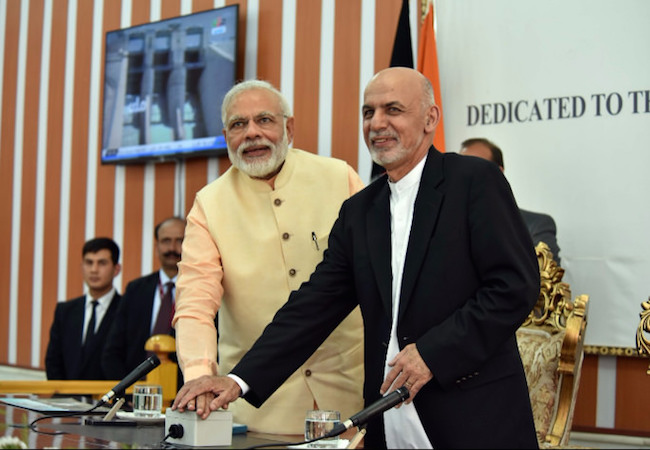The Salma Dam and expanding Indo-Afghan ties

By Shantanu Roy-Chaudhury
Indian Prime Minister Narendra Modi began his five-country tour on the 4th of June 2016 by visiting Afghanistan. Along with Afghan President Ashraf Ghani, Prime Minister Modi inaugurated the much awaited Salma Dam located on the Hari River in the Herat Province in western Afghanistan. The hydroelectric and irrigational dam, which has now been renamed the Afghan-India Friendship Dam is a $290 million project that is one of the largest developmental projects India has undertaken in Afghanistan, in its plan to rebuild the country. Water from this dam will help improve economic opportunities in a region that has been devastated by a 15-year drought by irrigating 75,000 hectares of land and generating 42 MW of power.
Over 1,500 Indians and Afghan engineers were involved in the construction of the dam for several years in difficult conditions.[1] Apart from security concerns around the area, there was also a long list of logistical challenges. The dam was in a site so remote that project officials had to be flown in and out by the Afghan Government once every month. Project material and equipment also had to be first shipped to Iran from where they were transported to Afghanistan, as transit through Pakistan was not possible.[2]
The completion of this dam is an important step towards stability and improving the economy in this war ravaged nation. With the country’s economic future in question after Western aid began to shrink due to security concerns, and the reduction of foreign troops, it was important that India stepped in to fill the void and continued to assist in the development of the country. Afghan President Ashraf Ghani stated that the completion of this dam was a “big step in deepening and broadening the relationship between Afghanistan and India.”[3]
Prime Minister Modi promised the Afghans that “India will not forget you or turn away,”[4] in a speech televised throughout the country. He added that “Your friendship is our honour; your dreams are our duty,”[5] and thanked Afghanistan’s security services for protecting Indians throughout the duration of the project.
Over the last 15 years, India has spent around $2 billion to help complete nearly 200 projects in Afghanistan, which include the construction of institutional buildings, hospitals, transmission plants, roads, etc. apart from the training imparted to Afghans in various fields including its armed forces, and scholarships provided to study in India. Its major projects include the construction of the Zaranj-Delaram road, the installation of power transmission lines from northern Afghanistan to Kabul, and the construction of the Afghan parliament building in Kabul. This makes India one of the leading donor nations to Afghanistan. India believes that sustainable development of Afghanistan requires long-term investment to help it exploit its natural resource wealth. The country is thus, at the forefront in promoting investment in Afghanistan.[6] The Indian investment in Iran’s Chabahar port and the trilateral agreement between India, Afghanistan and Iran for the ease of movement of goods will also provide Afghanistan a much needed direct outlet to the ocean, thus giving a boost to its economic opportunities.
This being Prime Minister Modi’s second visit in six months shows a renewed interest in the country, especially after Pakistan agreed to work closely with China to support the Afghan peace process.[7] The completion of the dam certainly won the hearts of the Afghan community and sparked a pro-India sentiment, which is important looking at India’s strategic aims in the region. Friendly relations with Afghanistan will allow India to overcome the strategic encirclement imposed by China and Pakistan, and will allow India to expand its trade market to the developing regions in Central Asia.[8]
Even though India does not share a land border with Afghanistan, the country is a priority for India for two main reasons. The first being to ensure that there is no export of terrorism from Afghanistan which could stem from Pakistan based anti-India terror groups being given a safe haven for training in the Taliban controlled regions in Afghanistan. The second is to promote a stable and independent Afghanistan with minimal external interference. This would also help India counter Pakistani interference in Afghanistan that seeks to marginalise Indian influence in the country.[9]
This developmental diplomacy followed by India will certainly help cement Indo-Afghan ties and will increase the country’s global footprint.
References
- Press Trust of India, 12th June 2016, Afghan Senate Thanks India For Construction Of Friendship Dam, NDTV, http://www.ndtv.com/india-news/afghan-senate-thanks-india-for-construction-of-friendship-dam-1418225
- Edit, 8th June 2016, Afghan project a huge win for Indian diplomacy, The Pioneer, http://www.dailypioneer.com/columnists/edit/the-salma-dam-challenge.html
- M. Reyaz, 4th July 2016, Modi’s ‘friendship dam’ is historic for Afghanistan, DailyO, http://www.dailyo.in/politics/modi-afghanistan-visit-salma-dam-tapi-ashraf-ghani-india-pakistan/story/1/11022.html
- Praveen Swami, 5th June 2016, At Afghan dam inauguration, PM promises: India will not forget you, The Indian Express, http://indianexpress.com/article/india/india-news-india/narendra-modi-afghanistan-salma-dam-inauguration-ashraf-ghani-2834106/
- Ibid.
- Indo-Afghan Relations, Embassy of India Kabul, Afghanistan, http://eoi.gov.in/kabul/?0354?000
- The Citizen Bureau, 5th June 2016, Salma Dam Cements India-Afghan Ties, The Citizen, http://www.thecitizen.in/index.php/NewsDetail/index/5/7877/Salma-Dam-Cements-India-Afghan-Ties
- Somya Rajawat, 8th June 2016, Completion of Salma Dam Sparks Pro-India Sentiment in Afghanistan, Future Directions International, http://www.futuredirections.org.au/publication/completion-salma-dam-sparks-pro-india-sentiment-afghanistan/
- Rahul Roy-Chaudhury, Chapter 5: India and Afghanistan, DGSI Papers No 1: Afghanistan in Regional Context: Insights from Regional States, Durham University,




